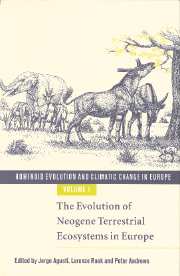Book contents
- Frontmatter
- Contents
- List of contributors
- Acknowledgements: The European Science Foundation
- 1 Introduction
- PART I Palaeogeography of the circum-Mediterranean region
- 2 Mediterranean and Paratethys Palaeogeography during the Oligocene and Miocene
- 3 Pliocene tephra correlations between East African hominid localities, the Gulf of Aden, and the Arabian Sea
- 4 Climatic perspectives for Neogene environmental reconstructions
- PART II Miocene mammalian successions
- PART III Palaeoenvironments: non-mammalian evidence
- PART IV Palaeoenvironments: mammalian evidence
- Index
4 - Climatic perspectives for Neogene environmental reconstructions
from PART I - Palaeogeography of the circum-Mediterranean region
Published online by Cambridge University Press: 15 December 2009
- Frontmatter
- Contents
- List of contributors
- Acknowledgements: The European Science Foundation
- 1 Introduction
- PART I Palaeogeography of the circum-Mediterranean region
- 2 Mediterranean and Paratethys Palaeogeography during the Oligocene and Miocene
- 3 Pliocene tephra correlations between East African hominid localities, the Gulf of Aden, and the Arabian Sea
- 4 Climatic perspectives for Neogene environmental reconstructions
- PART II Miocene mammalian successions
- PART III Palaeoenvironments: non-mammalian evidence
- PART IV Palaeoenvironments: mammalian evidence
- Index
Summary
Ex Africa semper aliquid novi
(Pliny the Elder)Introduction
Paleoenvironmental reconstructions are based on theoretical implications (Milankovitch cycles, etc.) and empirical evidence (e.g. paleontology). The general tendency is to attempt to articulate the latter with the former to try to make scanty empirical evidence fit theoretical expectations. Under the current paradigm, the major tendency is to assume that climatic changes in the mid-to-high latitudes (especially those involving temperature) drive those in the tropics. Another major tendency is to assume that temperature changes in the oceans are reasonable analogs for temperature changes on land. There are reasons to doubt these practices. Some ideas and evidence for why they can be inappropriate are presented below, based on how climate operates today, on how it theoretically relates to spatio-temporal variations in biological activity, how it relates to woody-plant species richness (a partial proxy for vegetation structure/complexity), and on the little that is known about the physiography, climate and vegetation of Pliocene Africa.
Four key topics considered below are: 1) how both precipitation and temperature need to be considered when evaluating changes in climate/vegetation; 2) how changes in climate/vegetation can be a function of regional-to-local changes in physiography rather than global climatic change (e.g. Milankovitch cycles); 3) how wetlands, especially grasslands resulting from impeded drainage, make grass pollen an ambiguous indicator of paleoclimate change in Africa; and 4) how climate's relation to woody-plant species richness, and thus vegetation, can be used to elucidate paleoecological anomalies.
Although we focus primarily on Africa and on understanding Pliocene environmental changes, we expect that some of the ideas, implications, and questions raised herein apply to other time periods, as well as elsewhere in the world, especially Eurasia.
- Type
- Chapter
- Information
- Hominoid Evolution and Climatic Change in Europe , pp. 55 - 82Publisher: Cambridge University PressPrint publication year: 1999
- 1
- Cited by

